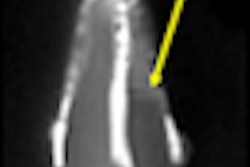Researchers from Kyushu University and University of Hong Kong have developed a unique approach for evaluating the image quality of digital intraoral radiographic systems, according to a study in Oral Radiology (June 11, 2011).
They used perceptibility curves (PCs) in a grayscale domain to compare four intraoral systems: CDR (Schick Technologies), Dixel (J. Morita), Digora (Soredex), and Digora Optime (Soredex). First they took radiographs of an aluminum phantom with 12 steps using all four systems. Then they measured the mean gray values and their standard deviations for each step, as well as the background of the images for each device.
The minimum perceptible gray level differences at a given exposure were calculated from the mean gray values and standard deviations, and a PC in the grayscale domain was constructed at each exposure for all devices. By combining all the PCs for all four systems, the maximum perceptible contrast information in each system was calculated. The correlation between the perceptible contrast information and the number of perceptible holes by observers at each exposure was examined for all four digital systems.
The Dixel and Digora Optime showed similar PCs, and their minimum perceptible gray level differences were the smallest among the systems, the authors noted. The correlation between the number of perceptible holes and the areas under the PCs at each exposure for the four systems was relatively high (r = 0.92).
"The areas under the PCs in a grayscale domain were highly correlated with observer performance," the researchers concluded. "This method can be used to evaluate the image quality of new digital systems."



















